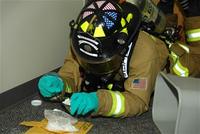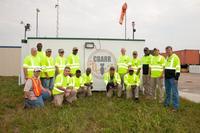-
Footwear safety reflectors help in detecting bioterror threats

Tiny versions of the reflectors on sneakers and bicycle fenders that help ensure the safety of runners and bikers at night are moving toward another role in detecting bioterrorism threats and diagnosing everyday infectious diseases, scientists said the other day.
-
-
Arsenic contamination in food and water supplies
After virtually eliminating arsenic as a useful tool for homicide, science now faces challenges in doing the same for natural sources of this fabled old “inheritance powder” that contaminates water supplies and food, threatening more than thirty-five million people worldwide.
-
-
Concerns grow over repeated safety failures at U.S. BioLabs
According to a report that was released by the Government Accountability Office (GAO) late last month, the United States is at a high risk for accidents at laboratories which conduct research on potential bioterror germs such as anthrax because federal officials have failed to develop national standards for lab design, construction, and operation.
-
-
Finding the right tools to respond to suspicious powder incidents

HazMat teams across the United States respond to hundreds of white powder calls each year in large cities where quick decision-making is critical. DHS makes it easier to buy the right technology for bio-threat incidents.
-
-
New device will quickly detect botulinum, ricin, other biothreat agents
Researchers are developing a medical instrument which will be able quickly to detect a suite of biothreat agents, including anthrax, ricin, botulinum, shiga, and SEB toxin. The device, once developed, approved by the Food and Drug Administration (FDA), and commercialized, would most likely be used in emergency rooms in the event of a bioterrorism incident.
-
-
U.S. nuclear industry faces a wave of nuclear power station retirements
A wave of U.S. nuclear power station retirements is on the horizon. The typical design life of a nuclear power plant is 40 years. There are 104 nuclear power plants in the United States, and their average age is 34 years — only a few years short of, and fast approaching, their design life. Almost 30 U.S. commercial and research reactors already have started decommissioning. A $400 million is regarded as the bargain basement price tag for cleaning up a single reactor.
-
-
Same-day water test keeps beaches open, swimmers’ health protected

With warm summer days at the beach on the minds of millions of winter-weary people, scientists are reporting that use of a new water quality test this year could prevent unnecessary beach closures, while better protecting the health of swimmers.
-
-
Large robotic jellyfish to patrol the oceans

The Office of Naval Research wants to place self-powering, autonomous machines in waters for the purposes of surveillance and monitoring the environment, in addition to other uses such as studying aquatic life, mapping ocean floors, and monitoring ocean currents. Researchers have built a device for that purpose — a life-like, autonomous robotic jellyfish the size and weight of a grown man, 5 foot 7 inches in length and weighing 170 pounds.
-
-
Nanobiotechnology kills listeria, other food-borne pathogens, dead
Researchers, using nature as their inspiration, successfully attached cell lytic enzymes to food-safe silica nanoparticles, and created a coating with the demonstrated ability selectively to kill listeria — a dangerous foodborne bacteria that causes an estimated 500 deaths every year in the United States. The coating kills listeria on contact, even at high concentrations, within a few minutes without affecting other bacteria.
-
-
A more powerful terahertz imaging system developed
Low-energy terahertz radiation could potentially enable doctors to see deep into tissues without the damaging effects of X-rays, or allow security guards to identify chemicals in a package without opening it. An electrical engineering research team has developed a laser-powered terahertz source and detector system which transmits with fifty times more power and receives with thirty times more sensitivity than existing technologies. This offers 1,500 times more powerful systems for imaging and sensing applications.
-
-
More than 10,000 pesticides approved by EPA without rigorous review
Congress allowed the Environmental Protection Agency (EPA) to use what is called “conditional registration” to approve pesticides deemed especially beneficial for food production – even before all the toxicity tests have been completed. Congress intended conditional registration to be used only sparingly, but the EPS has been using the loophole in a wholesale fashion to approve 65 percent – or more than 10,000 – of the 16,000 pesticides submitted to it for approval. The EPA cannot easily track the history of conditionally approved pesticides to determine whether required toxicity data was submitted, whether that caused a dangerous use of a pesticide to be cancelled, or whether the uses or restrictions should be modified based in such data.
-
-
U.S. Army helps in chemical testing of meat product

When a South Dakota beef producer voiced concerns over the safety of its product to a meat inspection staff, the Animal Disease Research and Diagnostic Laboratory at South Dakota State University, called on the U.S. Army Research, Development and Engineering Command’s chemical-biological center (ECBC) – and the ECBC answered.
-
-
Lawmakers call on TSA to reverse knife rule
Two leading lawmakers have called on TSA to reverse its ruling which would allow passengers to bring some types of knives with them on board. “The attacks on September 11, 2001, demonstrated that in the confined environment of an airplane, even a small blade in the hands of a terrorist can lead to disaster,” Rep. Ed Markey (S-Mass.) — who is running for the U.S. Senate seat recently vacated by John Kerry – wrote TSA director John Pistole.
-
-
Ohio’s Perry nuclear power plant was vulnerable to sabotage
A report issued last week said that operators at the Perry Nuclear Power Plant in Ohio found a vulnerability in the security of the plant last year, and that that vulnerability could have put the public in harm’s way. The utility operating the nuclear plant reported to the Nuclear Regulatory Commission (NRC) that the plant’s security program for monitoring underground pathways and other unattended openings were insufficient to detect and prevent unauthorized access to the protected area.
-
-
New radioactive waste repackaging facility in Los Alamos
The Los Alamos National Laboratory has brought a third waste repackaging facility online to increase its capability to process nuclear waste for permanent disposal. The box line facility is largest of its kind ever built.
-
More headlines
The long view
Keeping the Lights on with Nuclear Waste: Radiochemistry Transforms Nuclear Waste into Strategic Materials
How UNLV radiochemistry is pioneering the future of energy in the Southwest by salvaging strategic materials from nuclear dumps –and making it safe.
Model Predicts Long-Term Effects of Nuclear Waste on Underground Disposal Systems
The simulations matched results from an underground lab experiment in Switzerland, suggesting modeling could be used to validate the safety of nuclear disposal sites.
